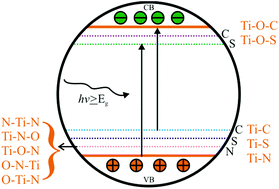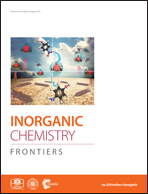C–N–S tridoping into TiO2 matrix for photocatalytic applications: observations, speculations and contradictions in the codoping process†‡
Abstract
The bulk heterostructuring of TiO2via codoping with nonmetals still holds possibilities for the potential development of a visible light photocatalyst and for overcoming the obstacles bracketed with metal ion substitution. In particular, tridoping of C–N–S into TiO2 was spotlighted with due consideration of its mesmerizing features like simultaneous and relatively low energy substitution of carbon, nitrogen and sulfur from the available precursors (thiourea, L-cystine and L-cysteine), stabilization of the anatase crystal structure, red shift in the band gap response towards the solar spectrum, cooperative interactions with these codopants, and the absence of any impure phase formation even at elevated temperature and with high doping density during the substitution process. Despite these flexibilities, accessible reports on C–N–S-TiO2 are not extensive and the discussions presented are far from the relevant aspects of the doping mechanism. With the intention of shedding light on the pros and cons of C–N–S-TiO2, this review is framed with the following viewpoints: (i) underscoring their beneficial effects in photocatalysis; (ii) underlining the doping mode of each dopant in the codoped system with respect to the reaction conditions; (iii) contradictions about the doping states of each dopant in the codoped system with reference to the previous literature; (iv) tentative discussion concepts like modifications of defect structures, dopant distribution, doping mode, mutual interferences among the dopants and crystallization kinetics in the course of codoping. The results emphasize that the codoping process involving carbon, nitrogen and sulfur is quite obfuscated as several doping modes are witnessed for each dopant, which are coupled to other factors like dopant diffusivity and solubility, extent of doping, dopant segregation at the surface, nature of the dopant precursor, unpredictable interactions of the dopant states, and interactive reactions between the dopant and titania precursor together with the annealing conditions. With critical analysis with reference to TiO2, it is envisaged that thiourea is the best functional precursor to attain diverse doping states for nitrogen, and cationic and anionic doping states for carbon and sulfur, together with the formation of adsorbed sulfate anions. Future research must shed light on the dopant–dopant and dopant–lattice interactions followed by their synergism at the structure-electronic level to uncover the doping mechanism in the codoped systems.

- This article is part of the themed collection: 2017 Inorganic Chemistry Frontiers Review-type Articles


 Please wait while we load your content...
Please wait while we load your content...